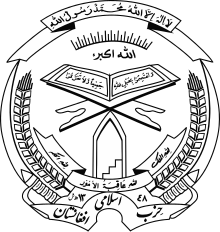Hizb-i Islāmī (Hekmatyār)
| Hizb-i Islāmī | |
|---|---|
| Self-labeling | Persian حزب اسلامی, DMG Ḥezb-i Islāmī , 'Islamic Party' |
| founder | Gulbuddin Hekmatyār |
| Founded | 1973 |
| Headquarters | Kabul |
| ideology | Pan-Islamism |
| distribution | Afghanistan |
The Hizb-i Islāmī ( Persian حزب اسلامی, DMG Ḥezb-i Islāmī , 'Islamic Party') is the oldest Islamist party in Afghanistan . Under the leadership of Gulbuddin Hekmatyār , it played a central role in the fight against the Soviet occupation and the Afghan civil war in the 1980s and 1990s . However, after the Taliban conquered Kabul in 1996, it lost a lot of its influence and split up after the new Afghan state was founded in 2001.
development
The Hizb-i Islāmī emerged in 1973 from the student organization Dschawānān-i Mosalmān ("Muslim Youth"), which emerged in the 1960s at Kabul University as a counterweight to the rising Marxists .
After Mohammed Daoud Khan seized power in 1973, she went into exile in Pakistan . From there she prepared an uprising against the regime in Kabul in 1975. However, due to insufficient support from the population, this failed. After the Communist coup in 1978 and the Soviet intervention in 1979 , it took up armed resistance. Thanks to her good contacts with the Pakistani secret service ISI and Saudi donors, she played an important political and military role. After the withdrawal of the Soviet troops in 1988 and the fall of the communist regime in 1992, it formed a transitional government together with other Islamist parties under the leadership of Burhānuddin Rabbāni .
However, the Hizb-i Islāmī withdrew prematurely from the government and tried to forcibly seize power. For years she fought a bloody civil war with the government of President Rabbāni , in the course of which tens of thousands of people died and Kabul was largely destroyed. In addition to ideological, ethnic causes also played a role: The Rabbānis party, the Jamiat-i Islāmi , was mainly supported by the Tajiks , the Hizb-i Islāmī mainly by the Pashtuns . In addition, there was personal rivalry with the military leader of the Jamiat-i Islāmī, Ahmad Shah Massoud . He knew Hekmatyār from student days, but had distrusted him since the failed uprising of 1975.
It was not until the Taliban captured Kabul in 1996 that the conflict ended. After the Northern Alliance had recaptured Kabul with American support in autumn 2001 , Hekmatyār called for a fight against the government of Hamid Karzai in 2002 and joined forces with the Taliban. However, not all parts of the Hizb-i Islāmī followed his call. In the summer of 2005, for example, part of the party agreed to participate in the parliamentary elections. With forty MPs it is the largest parliamentary group in the Wolesi Jirga (lower house) and is one of the most important pillars of the government. The section led by Hekmatyār, however, continued its destructive obstructionist policy with the murder of politicians, police officers and teachers. It can be assumed that he will continue to receive support from the Pakistani secret service. In September 2016, the Afghan government signed a peace agreement with Hezb-i Islami. In this agreement, the leader of Hezb-i Islami, Gulbuddin Hekmatyar, is guaranteed an amnesty for his past deeds. In addition, certain Hezb-i Islami fighters are being released from prisons. The government also promised to work to lift international sanctions against Hekmatyar.
ideology
The Hizb-i Islāmī is considered to be particularly radical and dogmatic in its ideological orientation. Similar to the Pakistani Jamiat-e Eslami, it has a strictly hierarchical and centralized structure. Originally, its members came mainly from the educated, urban middle class, but as the conflict became ethnic, it became the party of the Pashtun minority in northern Afghanistan. The high ideological demands that it placed on its members as well as its uncompromising and ruthlessness prevented it from finding broad support. The systematic policy of obstruction in the 1990s, which contributed significantly to the failure of the government and paved the way for the success of the Taliban, has cost it further sympathy. Nevertheless, like no other Islamist party, it shaped the political discourse in Afghanistan.
Party of Chalis
Another Islamist party exists in Afghanistan under the name Hizb-i Islāmī, which split off from the Hekmatyārs party at the beginning of the 1980s under the leadership of Junis Khalis . The party known as Hizb-i Islāmī (Chalis) , however, played a much smaller role politically and militarily and has only been of marginal importance since the death of its leader in July 2006.
literature
- Gilles Dorronsoro: La Révolution Afghane. Des communistes aux tâlebân . Éditions Karthala, Paris 2000, ISBN 2-84586-043-9 .
- David B. Edwards: Before Taliban. Genealogies of the Afghan Jihad . University of California Press, Berkeley CA et al. 2002, ISBN 0-520-22861-8 .
- Asta Olesen: Islam and Politics in Afghanistan (= Nordic Institute of Asian Studies . Volume 67 ). Routledge Curzan, Richmond 1995, ISBN 0-7007-0299-7 .
- Olivier Roy: L'Afghanistan. Islam et modernité politique . Éditions du Seuil, Paris 1985, ISBN 2-02-008744-8 .
Individual evidence
- ↑ Afghanistan: Hezb-i-Islami armed group signs peace deal. In: www.aljazeera.com. Retrieved September 23, 2016 .
